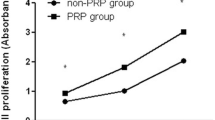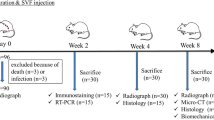Abstract
Purpose
There is evidence showing that mesenchymal stromal cells (MSC) may constitute a potential therapeutic strategy to induce bone regeneration. In this work, we investigate the capacity of autologous bone marrow (BM) MSC loaded on collagen microspheres (CM) and included into autologous platelet-rich plasma (PRP) clots (MSC/CM/PRP) to induce bone formation in patients with nonunion lesions.
Methods
MSC were isolated from BM cells of patients with nonunion lesions. Phenotypical (marker expression) and functional studies (osteogenic differentiation) were performed. MSC were seeded on CM and included into autologous PRP clot (MSC/CM/PRP). The capacity of MSC/CM/PRP to induce bone formation was evaluated in three patients diagnosed with nonunion.
Results
MSC loaded on CM/PRP clots maintain their biological functions, in vitro. After three months, post-MSC transplantation, all patients showed evidence of osteogenesis at the site of nonunion. After one year, all patients showed a complete healing of the nonunion.
Conclusions
Our results support the use of autologous MSC transplanted as MSC/CM/PRP for the treatment of nonunion fractures. Future studies incorporating a larger number of patients may confirm the results obtained in this work.





Similar content being viewed by others
References
Marsell R, Einhorn TA (2010) Emerging bone healing therapies. J Orthopaedic Trauma (Suppl 1):S4–S8. doi: 10.1097/BOT.0b013e3181ca3fab
Einhorn TA (1995) Current concepts review enhancement of fracture-healing. J Bone Joint Surg Am 77:940–946
Marsell R, Einhorn TA (2011) The biology of fracture healing. Injury 42:551–555
Flouzat-Lachaniette CH, Heyberger C, Bouthors C et al (2015) Osteogenic progenitors in bone marrow aspirates have clinical potential for tibial non-unions healing in diabetic patients. Int Orthop. doi:10.1007/s00264-015-3046-6
Homma Y, Zimmermann G, Hernigou P (2011) Cellular therapies for the treatment of non-union: the past, present and future. Injury (Suppl 1):S46–S49. doi: 10.1016/S0020-1383(13)70011-1
Janicki P, Schmidmaier G (2011) What should be the characteristics of the ideal bone graft substitute? Combining scaffolds with growth factors and/or stem cells. Injury (Suppl 2):77–81
Pittenger MF, Mackay AM, Beck SC et al (1999) Multilineage potential of adult human mesenchymal stem cells. Science 284:143–147
Hernigou P (2015) Bone transplantation and tissue engineering, part IV. Mesenchymal stem cells: history in orthopedic surgery from Cohnheim and Goujon to the Nobel Prize of Yamanaka. Int Orthop 39:807–817
Winkler S, Niedermair T, Füchtmeier B et al (2015) The impact of hypoxia on mesenchymal progenitor cells of human skeletal tissue in the pathogenesis of heterotopic ossification. Int Orthop 39:2495–2501
Dominici M, Le Blanc K, Mueller I et al (2006) Minimal criteria for defining multipotent mesenchymal stromal cells. The International Society for Cellular Therapy Position Statement. Cytotherapy 8:315–317
Fayaz HC, Giannoudis PV, Vrahas MS et al (2011) The role of stem cells in fracture healing and nonunion. Int Orthop 35:1587–1597
Steinert AF, Rackwitz L, Gilbert F et al (2012) The clinical application of mesenchymal stem cells for musculoskeletal regeneration: current status and perspectives. Stem Cells Trans Med 1:237–247
Hernigou P, Guissou I, Homma Y et al (2015) Percutaneous injection of bone marrow mesenchymal stem cells for ankle non-unions decreases complications in patients with diabetes. Int Orthop 39:1639–1643
Usami K, Mizuno H, Okada K et al (2009) Composite implantation of mesenchymal stem cells with endothelial progenitor cells enhances tissue-engineered bone formation. J Biomed Mater Res A 90:730–734
Cvetković VJ, Najdanović JG, Vukelić-Nikolić M et al (2015) Osteogenic potential of in vitro osteo-induced adipose-derived mesenchymal stem cells combined with platelet-rich plasma in an ectopic model. Int Orthop 39:2173–2180
Acknowledgments
This work was supported by funds from FONACIT (Fondo Nacional de Ciencia, Tecnología e Investigación), Project No. G-2005000405, and LOCTI Project No. 2011000906
Author information
Authors and Affiliations
Corresponding authors
Ethics declarations
Conflict of interest
Authors declare that they do not have any conflict of interest to disclose.
Rights and permissions
About this article
Cite this article
Wittig, O., Romano, E., González, C. et al. A method of treatment for nonunion after fractures using mesenchymal stromal cells loaded on collagen microspheres and incorporated into platelet-rich plasma clots. International Orthopaedics (SICOT) 40, 1033–1038 (2016). https://doi.org/10.1007/s00264-016-3130-6
Received:
Accepted:
Published:
Issue Date:
DOI: https://doi.org/10.1007/s00264-016-3130-6




